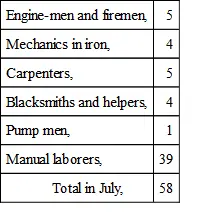Tappan Wentworth - Report of the Hoosac Tunnel and Troy and Greenfield Railroad, by the Joint Standing Committee of 1866
Здесь есть возможность читать онлайн «Tappan Wentworth - Report of the Hoosac Tunnel and Troy and Greenfield Railroad, by the Joint Standing Committee of 1866» — ознакомительный отрывок электронной книги совершенно бесплатно, а после прочтения отрывка купить полную версию. В некоторых случаях можно слушать аудио, скачать через торрент в формате fb2 и присутствует краткое содержание. Жанр: foreign_antique, Технические науки, foreign_edu, на английском языке. Описание произведения, (предисловие) а так же отзывы посетителей доступны на портале библиотеки ЛибКат.
- Название:Report of the Hoosac Tunnel and Troy and Greenfield Railroad, by the Joint Standing Committee of 1866
- Автор:
- Жанр:
- Год:неизвестен
- ISBN:нет данных
- Рейтинг книги:5 / 5. Голосов: 1
-
Избранное:Добавить в избранное
- Отзывы:
-
Ваша оценка:
- 100
- 1
- 2
- 3
- 4
- 5
Report of the Hoosac Tunnel and Troy and Greenfield Railroad, by the Joint Standing Committee of 1866: краткое содержание, описание и аннотация
Предлагаем к чтению аннотацию, описание, краткое содержание или предисловие (зависит от того, что написал сам автор книги «Report of the Hoosac Tunnel and Troy and Greenfield Railroad, by the Joint Standing Committee of 1866»). Если вы не нашли необходимую информацию о книге — напишите в комментариях, мы постараемся отыскать её.
Report of the Hoosac Tunnel and Troy and Greenfield Railroad, by the Joint Standing Committee of 1866 — читать онлайн ознакомительный отрывок
Ниже представлен текст книги, разбитый по страницам. Система сохранения места последней прочитанной страницы, позволяет с удобством читать онлайн бесплатно книгу «Report of the Hoosac Tunnel and Troy and Greenfield Railroad, by the Joint Standing Committee of 1866», без необходимости каждый раз заново искать на чём Вы остановились. Поставьте закладку, и сможете в любой момент перейти на страницу, на которой закончили чтение.
Интервал:
Закладка:

A resident engineer was stationed at the East End in charge of the work.
The progress of the excavations at the East End heading for the year ending December, 1866, has been 569 feet; at the rate of 47.42 per month.
The progress during the six months ending May, 1866, was 338 feet; an average per month of 56 feet 4 inches. One week was lost in June in introducing the machine-drills, in consequence of which the progress that month was reduced to 50 feet 6 inches. During the five months ending November 30, the progress has been 219 1/ 2feet; being an average of 43.9 feet per month. It will be seen by the table, that in July, the first month after the introduction of the drill machines, the progress attained was only 26.5 feet. As the men became better acquainted with them, the progress was increased to 48 feet in August, and in September it rose to 54.5, having nearly attained the average progress of the six months preceding their introduction. Had there been an adequate supply, there can be little doubt that the progress would have continued to increase, and would have shown the superiority of the machine-drill over hand-labor; but the supply fell off, and the progress in October was reduced to 34 feet and 6 inches.
Table showing the progress at East End Heading, from November 1, 1865, to January 1, 1867.

The Central Shaft
There is at this point, used by the State in the prosecution of the work, the shaft-building, a carpenter's shop, a blacksmith's shop, a saw-mill, powder-house, gas-house, ash-house, wood-shed, and a barn; and in connection with the work, a store, a boarding-house, the Thacher farm-house and out-buildings, 4 first-class and 7 common shanties. The cost of buildings at the Central Shaft in July, 1866, was $11,080.13. The cost in November, 1866, was $12,026.83. The annual rent of that portion leased to operatives is $736.
A farm, containing 250 acres of land, with a dwelling-house and barn, has been purchased, adjoining the Central Shaft, for the sum of $3,000. The land was well covered with timber, about one-half of which has been cut for the purposes of the shaft and tunnel. There is estimated to be one million feet of hemlock timber still standing, which will be wanted in the progress of the work. This purchase was an advantageous one for the State, there having been already realized from it an amount equal to its cost.
The working force at the Central Shaft in July, 1860, was comprised of—

On the first day of November there were employed at this point, in all, 81. Of this number, 40 were engaged out of the shaft, and 41 in the shaft.
The above enumeration does not include the resident engineer and time-keeper, stationed here in November.
The depth of Central Shaft, when completed, will be 1,037 feet from the surface; its form is an ellipse, whose axes are 27 and 15 feet. On the fifth day of May it had reached the depth of 300.5 feet. At this time the hoisting apparatus was removed from the shaft, and the work of excavation ceased. The new hoisting apparatus was fitted on the first day of August, and the drilling commenced at midnight on that day.
Previous to the change in the hoisting apparatus, the monthly progress had averaged about 18 1/ 2feet per month. The advance in October and November was 46 feet; the gain over the previous rate of progress is attributable to the practice of simultaneous blasting.
On the first day of January, 1867, the shaft had been sunk 393 feet, leaving for excavation 644 feet.
Table showing the progress at Central Shaft from November 1, 1865, to December 1, 1866.

[A]Work suspended to put in new hoisting apparatus.
The present hoisting apparatus is expected to be sufficient to finish the shaft. It has two wire ropes, each 1,260 feet long. The time for a round trip is seven minutes. The engine here is of 100 horse-power. The blacksmith shop contains two forges. At the small machine shop the repairs required here are made, as also some repairs for the West Shaft.
The Central Shaft, though designed to aid in ventilating the tunnel, was intended also to accelerate its construction by affording to the process of excavation four faces instead of two during some portion of the work; and the former chairman of the commissioners expected by the aid of machine-drilling, the shaft might be completed in one year from the time such drilling should commence within it. In this anticipation, ten vertical drilling machines were constructed to work in the shaft area and a compressor with two cylinders was provided to furnish the power for operating them. The want of drilling machines at the East End became so urgent, that these vertical ones were changed to horizontals, and used at that point, and the sinking of the shaft by hand-drilling still continues. But if the experiments now in progress at the East End with the new drilling machine shall demonstrate its superiority over hand labor, the machine will doubtless be introduced into the shaft.
West Shaft
This shaft has an area of about 8 by 13 feet, and was excavated by Messrs. H. Haupt & Co. Its depth is 316 feet.
The buildings here used by the State are the West Shaft house, the New Shaft building, a blacksmith shop containing two forges, a powder-house, a horse-shed, ash-house and tank-house. The buildings owned by the State and leased to operatives are a boarding-house and four old shanties built by H. Haupt & Co., four first-class shanties, eight common shanties, and a double cottage. The buildings at the West End, are connected on the books with those at the West Shaft, and will be here enumerated. They consist of a carpenter's shop, time-keeper's office, a blacksmith shop containing one forge, tool-house, powder-house, horse-shed, brickyard shed, brickyard, engine-house, artesian wells Nos. 3 and 4, buildings, and two-thirds of a barn, which are occupied by the State. One boarding-house, store, one-third of a barn, the Harrington farm-house, barn and out-buildings, twenty-seven common shanties and brickyard boarding shanty. These buildings, with part of blacksmith shop, part of carpenter's shop and time-keeper's office, are rented to operatives and to Mr. Farren, the contractor for constructing the brick arch.

This large increase was mainly occasioned by the construction of a double cottage and necessary buildings at the brickyard and West End.
The amount of rents at these two points is $2,462.60 per annum. Fifteen of the tenements at the West End are leased to Mr. Farren, in accordance with his contract.
The working force at the West Shaft in July was,—

At this point there is one engine of 100-horse power and one of 40-horse power, and one compressor having four cylinders of a diameter of 13 inches and 24 inches stroke. The West heading from this shaft was advanced 293 feet, and the East heading 1,042, on the first day of December, 1866. The progress for the year ending November 1, 1866, at the heading at this point was 636.7, being a fraction over 53 feet per month. For the last four months, ending December 1, 1866, the progress was 322.1, being a fraction over 64 feet per month, which exceeds by four feet per month the highest estimate for hand-drilling by the engineers in 1862, and by thirty and one-third feet the estimate of Mr. Latrobe. The progress of the work at this heading during the last six months, making allowance for the influx of water in November, having exceeded the highest estimate for hand-drilling, should be regarded as evidence alike of the skill of the miners and the good management of the engineer and his subordinates.
Читать дальшеИнтервал:
Закладка:
Похожие книги на «Report of the Hoosac Tunnel and Troy and Greenfield Railroad, by the Joint Standing Committee of 1866»
Представляем Вашему вниманию похожие книги на «Report of the Hoosac Tunnel and Troy and Greenfield Railroad, by the Joint Standing Committee of 1866» списком для выбора. Мы отобрали схожую по названию и смыслу литературу в надежде предоставить читателям больше вариантов отыскать новые, интересные, ещё непрочитанные произведения.
Обсуждение, отзывы о книге «Report of the Hoosac Tunnel and Troy and Greenfield Railroad, by the Joint Standing Committee of 1866» и просто собственные мнения читателей. Оставьте ваши комментарии, напишите, что Вы думаете о произведении, его смысле или главных героях. Укажите что конкретно понравилось, а что нет, и почему Вы так считаете.












